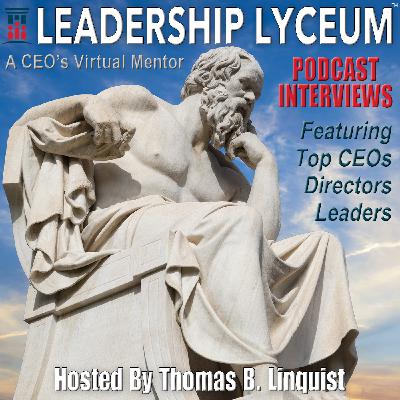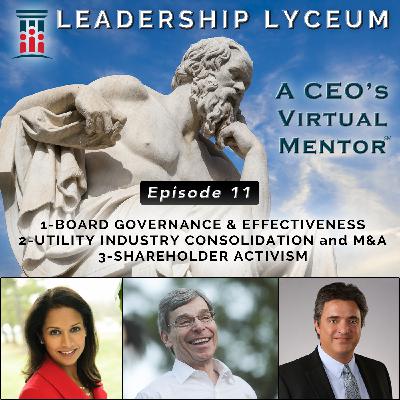"The Weight of Command: The Ehime Maru Tragedy and the Case for Transparency" with Admiral Thomas B Fargo
Description
"The Weight of Command:
The Ehime Maru Tragedy and the Case for Transparency"
with Admiral Thomas B Fargo
Welcome to Episode 29, Season 9 of A CEO's Virtual Mentor®
In this compelling episode of Leadership Lyceum: A CEO's Virtual Mentor®, we are joined by a distinguished leader whose career has been defined by service, responsibility, and command at the highest levels of the United States Navy.
Admiral Thomas B. Fargo served as a four-star admiral and commander of the United States Pacific Command, the largest unified command in the world, overseeing operations across half the globe.
Across not only his military career, but also across his board leadership service, Admiral Fargo is known for his steady hand in times of crisis and moral clarity under pressure: qualities that are grounded in his deep commitment to accountability and transparency. This episode of A CEO's Virtual Mentor® entitled "The Weight of Command: The Ehime Maru Tragedy and the Case for Transparency" reveals those qualities under the pressure of deep crisis and human tragedy in the aftermath of the tragic collision of the USS Greeneville, a nuclear-powered submarine, and the Japanese fishery training vessel, the Ehime Maru off Oahu on February 9th, 2001, a tragedy that took the lives of nine Japanese citizens, including four high school students.
As commander of the Pacific Fleet at the time, Admiral Fargo was responsible for the Navy's response. Our episode today takes us back almost 25 years ago to the incident and to the decisions in the aftermath.
The episode is divided into five segments:
1. The Incident: The story opens with a vivid recounting of the 2001 collision between the USS Greeneville, a U.S. Navy nuclear-powered submarine, and the Japanese training vessel Ehime Maru off Oahu. Admiral Fargo, then Commander of the Pacific Fleet, reflects on the moment he received the first report and the gravity of what unfolded—a tragedy that claimed nine lives and strained U.S.–Japan relations. The segment sets the stage for a crisis that would test not only naval command but also the moral fiber of leadership itself.
2. The Ever-Elusive Facts: In every crisis, the first reports are wrong. Admiral Fargo recounts how the Navy struggled to uncover the truth amid incomplete, often misleading information—compounded by legal, diplomatic, and media pressures. Drawing parallels to the 1988 USS Vincennes - Iranian Airbus tragedy, this segment examines the tension between speed and accuracy in crisis communication, and how early missteps can shape public perception for years.
3. The Investigation: With multiple options before him—a classified inquiry, internal settlement, court-martial, or a public court of inquiry—Admiral Fargo faced a defining choice. Guided by the principle that "some events cannot be delegated," he chose full transparency, rejecting secrecy even at the cost of institutional discomfort. This decision, rooted in lessons from the Navy's past, particularly the Tailhook scandal, set the tone for how the service would regain trust through openness.
4. The Court of Inquiry: The rare and rigorous process unfolds. Three senior flag officers—an aviator, a submariner, and a surface warfare officer—are appointed, joined symbolically by a Japanese admiral to safeguard the interests of the victims' families. As the inquiry proceeds under intense public scrutiny, painful truths emerge: procedural lapses, haste under pressure, and breakdowns in communication. The court's findings affirm accountability while preserving fairness—showing that leadership's true test lies in how justice is pursued when tragedy strikes.
5. Epilogue on Leadership in Reflection: In the closing segment, Admiral Fargo reflects on the enduring lessons of command—trusting one's instincts, fostering an environment where truth can be spoken freely, and upholding personal accountability even when law or policy might allow retreat. His story culminates in a powerful act of restitution: the unprecedented salvage of the Ehime Maru to recover the remains of the lost. Through this effort, Fargo demonstrated that the highest form of leadership lives not in procedure, but in conscience—in what Lord Moulton called "obedience to the unenforceable."
Program Guide
A CEO's Virtual Mentor® Episode 29
"The Weight of Command:
The Ehime Maru Tragedy and the Case for Transparency"
with Admiral Thomas B Fargo
0:00 Introduction to the program and to our guest, Ret. Admiral Thomas B. Fargo, Commander of the United States Pacific Command.
3:16 Part 1: The Incident
22:06 Break 1
22:12 Part 2: The Ever-Elusive Facts
30:35 Break 2
31:06 Part 3: The Investigation
41:17 Break 3
41:48 Part 4: The Court of Inquiry
48:06 Break 4 – Intermediate Break
48:12 Part 4: The Court of Inquiry (continued)
54:13 Break 5
54:22 Part 5: Epilogue on Leadership in Reflection
1:04:27 Lyceum's Reflective Closing Comments
We would like to express our special thanks to the clients of Lyceum Leadership Consulting that enable us to bring you this podcast.
Links to Biographies of Guests
Admiral Thomas B. Fargo
Your host Thomas B. Linquist is the Founder and Managing Director of Lyceum Leadership Consulting and Lyceum Leadership Productions. Over his 25 years in management and leadership consulting he has served a wide array of corporate clients. This includes leadership assessment and search for chief executive officers, chief financial officers, chief operating officers and directors of boards. He holds an MBA from the University of Chicago and over his 35-year career has served in a variety of roles: as an engineer with Shell Oil Company, a banker with ABN AMRO Bank, and as treasurer was the youngest corporate officer in the 150+ year history at










